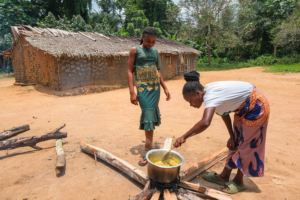The East African Community and the Eastern Congo Crisis
 The Democratic Republic of Congo (DRC) has endured more than three decades of conflict, with constant attacks on civilians and insecurity fueling a severe humanitarian crisis. Even before the recent surge in violence, 21 million people were internally displaced and in dire need of humanitarian assistance, a number that continues to rise daily. The ongoing DRC crisis in Eastern Congo has displaced more than 6 million people, creating a cycle of dependency on aid.
The Democratic Republic of Congo (DRC) has endured more than three decades of conflict, with constant attacks on civilians and insecurity fueling a severe humanitarian crisis. Even before the recent surge in violence, 21 million people were internally displaced and in dire need of humanitarian assistance, a number that continues to rise daily. The ongoing DRC crisis in Eastern Congo has displaced more than 6 million people, creating a cycle of dependency on aid.
This situation will likely worsen the DRC crisis due to funding shortages, including significant cuts from the United States, which accounted for 70% of the DRC’s aid in 2024. Despite these challenges, humanitarian organizations and regional neighbors like the East African Community (EAC) remain committed to fostering peace and delivering essential aid to the Congolese people.
First Congo War 1960-1965
Shortly after gaining independence from Belgium, chaos erupted as the Force Publique soldiers at the Thysville military base, marking the beginning of the DRC crisis. Congolese soldiers revolted against their white counterparts, demanding better wages. This unrest quickly escalated to other military bases, igniting widespread violence across the nation.
Just two days earlier, the provinces of Katanga and South Kasai had declared their independence from Congo. These post-colonial power struggles led to the assassination of Patrice Lumumba on January 17, 1961, which only deepened the chaos. On November 25, 1965, Mobutu Sese Seko seized power in a coup, renaming the country Zaire. He ruled until 1997 when he was ousted after decades of corruption and economic mismanagement.
The Rwanda Genocide and its Aftermath
When the Rwandan genocide ended in 1994, the Rwandan Patriotic Front (RPF) reclaimed the Rwandan capital, Kigali. The advance of the Tutsi-led rebels forced more than one million Hutu refugees to flee to the DRC (then Zaire), where they staged attacks against the Kigali government while being sheltered by Mobutu.
In 1996, the Rwandan Patriotic Army (RPA) and the Alliance of Democratic Forces for the Liberation of Congo-Zaire (ADFL), under the command of Laurent Kabila, conducted attacks on the camps. The war pitted the ADFL against Mobutu Sese Seko’s Zairian Armed Forces (FAZ), Interahamwe militia, Rwandan Armed Forces ex-FAR and mercenaries. This rebellion stoked ethnic tensions, particularly with the Banyamulenge Tutsis in eastern Congo and eventually led to the overthrow of Mobutu in 1997.
Second Congo War 1998-2003
After Mobutu fled to exile in Morocco, Kabila expelled all foreign soldiers, but the Hutu militias stationed in eastern Congo continued their attacks on Rwanda. In August 1998, Rwanda invaded eastern Congo with the support of Congolese Tutsi and rebel groups against Kabila. This marked the start of the Second Congo War, which drew in as many as 14 different armies, including troops from Angola, Namibia and Zimbabwe, who backed Kabila against Burundi, Uganda and Rwandan forces against Kabila.
The wars led to countless deaths, displacements and entrenched ethnic divisions and resource-driven conflicts in eastern Congo, leaving a legacy of instability that persists today.
The Role of the East African Community
The EAC is a regional intergovernmental organization comprising of Kenya, Uganda, Rwanda, Tanzania, South Sudan, Burundi, DRC and Somalia. The community has committed to maintaining peace and restoring stability in the DRC. Some of the interventions include:
- In July 1999, Rwanda, Uganda and four other warring nations signed the Lusaka Accord, formalizing a ceasefire to end the Second Congo War.
- In 2002, Rwanda and Uganda endorsed the Pretoria Agreement, while Uganda and the DRC agreed to withdraw Ugandan troops and restore bilateral relations under the Luanda Agreement.
- Between 2008 and 2009, Rwanda and DRC held joint military operations called Kimia to disarm armed groups in eastern DRC.
- In 2022, the EAC deployed regional forces to eastern DRC to work with the DRC forces to combat armed groups and support humanitarian efforts.
- In 2022, the EAC Nairobi Process emerged, rallying regional leaders, civil society and international partners to prioritize dialogue and negotiation, particularly pushing for dialogue between the government and M23.
- In 2023, the Joint EAC-SADC united regional leaders in committing to a lasting solution, urging peaceful coexistence. Despite setbacks, such as President Tshisekedi’s refusal to attend a virtual summit hosted by Kenya’s William Ruto in 2025, regional collaboration remains central to resolving the crisis.
Final Remarks
The East African Community has dedicated significant efforts to fostering dialogue and promoting peace in the DRC, from a conflict dynamic to peace initiatives. However, it has encountered various challenges and criticisms. The deployment and subsequent withdrawal of the EAC Regional Force underscored the need for a more effective approach to tackle the issues comprehensively.
The differing economic and political interests among member states complicate the mission to pursue peace, as these divergent priorities have prompted the DRC government to seek assistance from external parties, further exacerbating the country’s instability.
The DRC crisis is a complex weave of historical injustices, failed governance, external meddling and a lack of global concern. Achieving a lasting solution goes beyond ceasefires. It requires dismantling systems that favor resource exploitation at the expense of human dignity. It also calls for holding regional powers responsible for destabilizing and empowering Congolese communities to take charge of their recovery.
– Grace Ruria
Grace is based in Nairobi, Kenya and focuses on Technology and Politics for The Borgen Project.
Photo: Flickr
